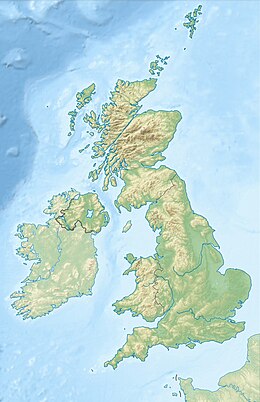
Oxfordshire is a landlocked county in the far west of the government statistical region of South East England. The ceremonial county borders Warwickshire to the north-west, Northamptonshire to the north-east, Buckinghamshire to the east, Berkshire to the south, Wiltshire to the south-west and Gloucestershire to the west.

Iford Manor is a manor house in Wiltshire, England. It is a Grade II* listed building sitting on the steep, south-facing slope of the Frome valley, in Westwood parish, about 2 miles (3.2 km) southwest of the town of Bradford-on-Avon. Its Grade I registered gardens are open to the public from April to September each year.
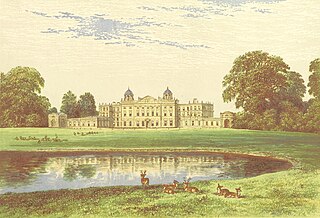
Badminton House is a large country house and Grade I Listed Building in Badminton, Gloucestershire, England, which has been the principal seat of the Dukes of Beaufort since the late 17th century. The house, which has given its name to the sport of badminton, is set among 52,000 acres of land. The gardens and park surrounding the house are listed at Grade I on the Register of Historic Parks and Gardens.
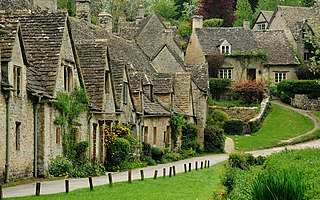
Bibury is a village and civil parish in Gloucestershire, England. It is on the River Coln, a Thames tributary that rises in the same (Cotswold) District. The village centre is 6+1⁄2 miles northeast of Cirencester. Arlington Row is a nationally notable architectural conservation area depicted on the inside cover of all British passports. It is a major destination for tourists visiting the traditional rural villages, tea houses and many historic buildings of the Cotswold District; it is one of six places in the country featured in Mini-Europe, Brussels.
Nether Lypiatt Manor is a compact, neo-Classical manor house in the mainly rural parish of Thrupp, near Stroud in Gloucestershire. It was formerly the country home of Prince and Princess Michael of Kent and is a Grade I listed building.

Stowell Park Estate is a 6,000-acre (24 km2) historic agricultural and sporting estate in the Cotswold Hills, Gloucestershire, England. The estate includes the village of Yanworth. The main house is a Grade II* listed building and surrounded by extensive parkland, a mill, and church. The landscaped park is listed Grade II on the Register of Historic Parks and Gardens.

Ablington is a village in the county of Gloucestershire, England. It is located in the Coln Valley and is part of the Bibury civil parish, 6 miles (9.7 km) north-east of Cirencester. Ablington is in the Cotswolds which has been designated by Natural England as an Area of Outstanding Natural Beauty (AONB).

Toddington Manor is a 19th-century country house in the English county of Gloucestershire, near the village of Toddington. It is in the gothic style and was designed by Charles Hanbury-Tracy, 1st Baron Sudeley for himself and built between 1819 and 1840. Upon completion, a volume on its architecture was published by John Britton (antiquary). It is a Grade I listed building.

Shilton is a village and civil parish about 1+1⁄2 miles (2.4 km) northwest of Carterton, Oxfordshire. The 2011 Census recorded the parish's population as 626.

The Stonehouse Court is a Grade II* listed manor house in Stonehouse, Gloucestershire, England which is now a hotel. It is located next to St Cyr's Church and the Stroudwater Canal.

Great Coxwell Barn is a Medieval tithe barn at Great Coxwell, Oxfordshire, England. It is on the northern edge of the village of Great Coxwell, which is about 9 miles (14 km) northeast of Swindon in neighbouring Wiltshire.

Acton Court is the historic manor house of the manor of Iron Acton in Gloucestershire, England. It is a grade I listed building of Tudor architure and was recently restored. It is situated, at some considerable distance from the village of Iron Acton and the parish church of St Michael, on Latteridge Lane, Iron Acton, South Gloucestershire, England. The Poyntz family owned the property from 1364 until 1680. Nicholas Poyntz added the East Wing onto the existing moated manor house shortly before 1535. Construction took about 9 months to complete. Subsequently, the wing was lavishly and fashionably decorated to impress Henry VIII. The king and his second wife, Anne Boleyn, stayed in the house in 1535, during a tour of the West Country. Building work continued at Acton Court until Nicholas died in 1557.

Nailsea Court in Nailsea, Somerset, England, is an English manor house dating from the 15th century. Pevsner describes the house as "historically highly instructive and interesting" and it is a Grade I listed building.

Great Coxwell is a village and civil parish 2 miles (3 km) southwest of Faringdon in the Vale of White Horse, England. It was in Berkshire until the 1974 boundary changes transferred it to Oxfordshire. The 2001 Census recorded the parish's population as 274.
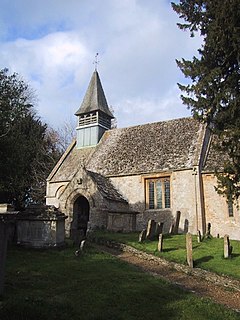
Westwell is a small village and civil parish about 2 miles (3 km) southwest of the market town of Burford in Oxfordshire. It is the westernmost village in the county, close to the border with Gloucestershire.
Eastleach House is Grade II listed country house in Eastleach Martin, Gloucestershire, designed by the architect Walter Cave and completed in 1900.
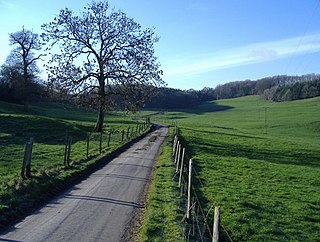
Kingscote Park is a grade II listed house and country estate in Kingscote, near Tetbury, Gloucestershire, England. The original Kingscote Park was demolished in 1951. Both houses formed part of the manor of Kingscote which was held by the Kingscote family from the 12th century and is mentioned in the Domesday Book as 'Chingescote'.
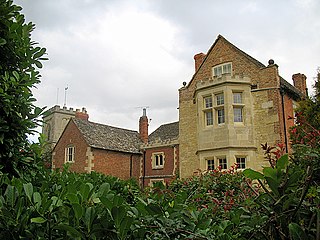
Brockworth Court is a Tudor house in the village of Brockworth, Gloucestershire, England. It is a Grade II* listed building.

Frampton Court is a Grade I listed country house and estate of about 1,500 acres (610 ha) in Frampton-on-Severn, Gloucestershire, England. It has been owned by the Clifford family since the 11th century. The main buildings are the 18th century Frampton Court and, on the opposite side of the village green, Manor Farm. The gardens at Frampton Court have a Gothic orangery and ornamental canal in the style of William Halfpenny. The two houses, barn and orangery are all Grade I listed buildings in their own right, while the Gatepiers and Gates are Grade II* listed.

Abbotswood is a country house and estate near Lower Swell in Gloucestershire, England. It is a grade II listed building and estate, of medieval origins and with remodelling and garden work to the designs of Sir Edwin Lutyens from 1901 onwards.



